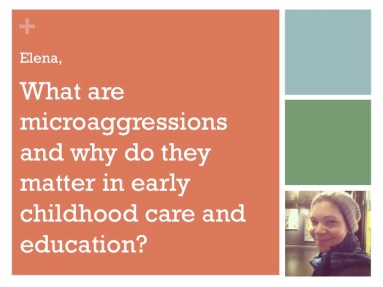This Real World Wednesday, we have the honor of learning from and with Elena Jaime!
Elena has taught in early childhood and early elementary settings for the past thirteen years. She is passionate about her mission to develop “angelic troublemakers” in the school communities in which she works. Elena’s work is grounded in the belief that young children are capable of developing a critical lens and can engage in reflection and action around anti-bias work. Elena has presented at a number of local and national conferences, and has partnered with teachers across New York City as they work to examine the ways in which they can fully integrate equity work into early childhood curriculums. Elena also co-founded the CARLE Institute for White educators, an institute designed to provide white faculty members with the necessary historical framework, interpersonal skills, and curriculum development strategies they need to teach a diverse student body. Elena teaches second grade at the Chapin School in New York City. Elena received her B.A. in psychology from Wesleyan University and her M.S.Ed in early childhood general and special education from Bank Street College of Education.
Elena wrote this powerful piece about how she used storytelling in the face of a microaggression that happened in her classroom: https://tobreatheispolitical.wordpress.com/tag/education/
Given her experience and expertise, we wanted to ask, “What are microaggressions and why do they matter in early childhood care and education?”
Here’s Elena’s thoughtful response:
As an early childhood educator, I have always valued the importance of creating safe spaces for my students, spaces in which children feel invited to bring their full selves each morning. The Responsive Classroom approach to teaching is an approach that is based on the premise that social-emotional growth and academic success are interdependent. Embedded in this understanding of education is the idea that children learn best when they feel a sense of belonging in a community. This sense of belonging, however, is undermined when a community does not think critically about the ways in which each member’s identity is embraced or marginalized.
Children notice difference. They are hardwired to observe patterns in their world, and as they develop, they begin to ascribe meaning to those differences. They do so by tapping into the messages that are communicated about the ways in which our society values or devalues different identities across race, gender, sexual identity, class, ability, etc. These messages, unless interrupted, become part of the lens they use to understand and interpret their world. As a result, the interactions that the students have with each other and with the adults in their schools and learning communities are infused with those messages. A kindergarten child being told that their skin looks dirty because it is black, a first grader telling her classmate that it is impossible for her to have two moms, or a teacher consistently confusing the two Asian students in her class are examples of moments in which a piece of a person’s identity is marginalized. These acts of marginalization based on a person’s identity have come to be known as microaggressions.
Microaggressions are often described as “small paper cuts” that represent all of the times that someone says or does something that further marginalize you because of your identity. As a queer, Christian, able-bodied, traditionally educated, English-speaking cisgender, woman of color in the United States, I will experience privileges that come with being a member of groups which wield power (political, social, economic, etc.), and I will also experience the marginalization that comes from being a member of groups that do not wield power in my American context.
If, as early childhood educators, we believe in the importance of creating safe learning spaces, where children can take risks, and if this necessitates that each child feels that they belong, then we have a responsibility to interrupt microaggressions that we witness and perpetuate in our learning environments. When we name those experiences for young children, we are helping them develop a lens with which they begin to see identify those moments of marginalization, and in turn, interrupt them. An important piece of this work belongs to the adults who must model what it means to bring their full selves into the classroom. When we do this, we are explicitly sending the message to students that each piece of who they are is valuable and belongs, and that the classroom would not be complete without every last piece.
Thank you, Elena, for this eloquent response and for all of the important work you do every day working with young children and their families. They are so lucky to have you in their lives! As are we!
Here are some additional reading on microaggressions:
-
Asian Stereotypes: Understanding How Microaggressions Impact Youth & Professionals panel discussion hosted by the Asian American Federation
-
Racial Microaggressions in Everyday Life: Is Subtle Bias Harmless? by Derald Wing Sue
-
This Is the Perfect Illustration of Why Microaggressions Hurt by Alli Kirkham
-
How Does Oppression (Microaggressions) Affect Perpetrators? The Cognitive, Affective, Behavioral, and Spiritual Costs of Oppression by Derald Wing Sue
-
Microaggressions: More Than Just Race by Derald Wing Sue
-
Illustration: Microaggressions in the Classroom Reporting by Sarah D. Sparks, Illustration by Vanessa Solis
-
Microaggressions are a form of discrimination — even kids know that by Eve Vawter